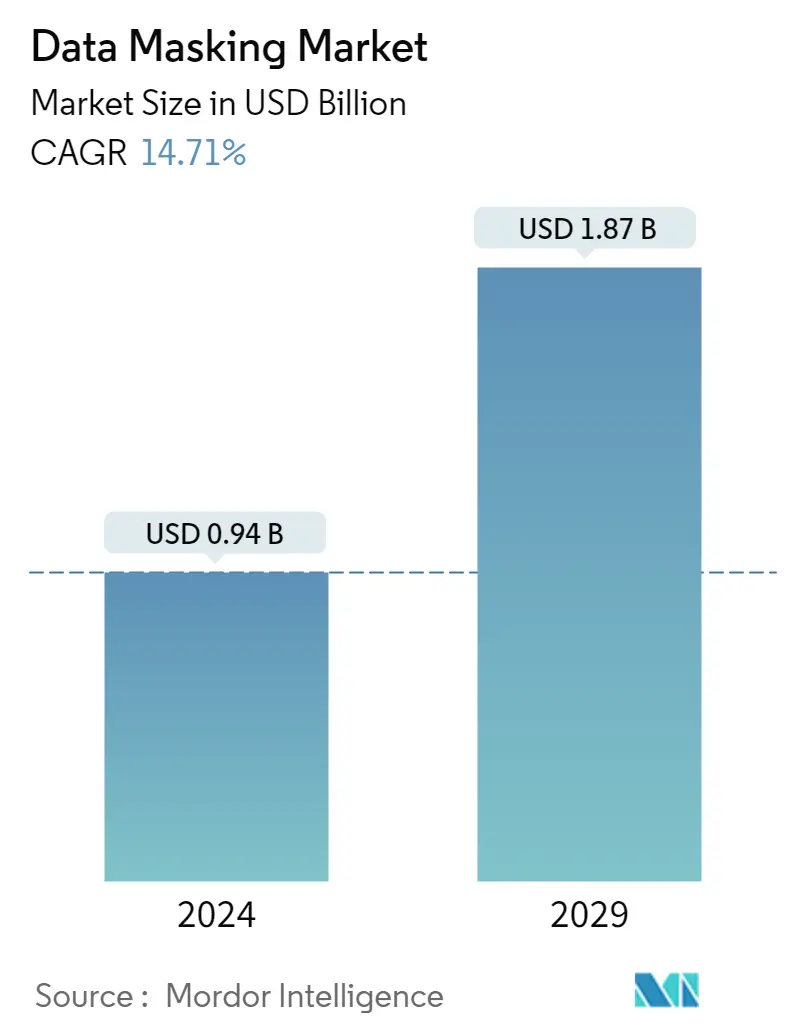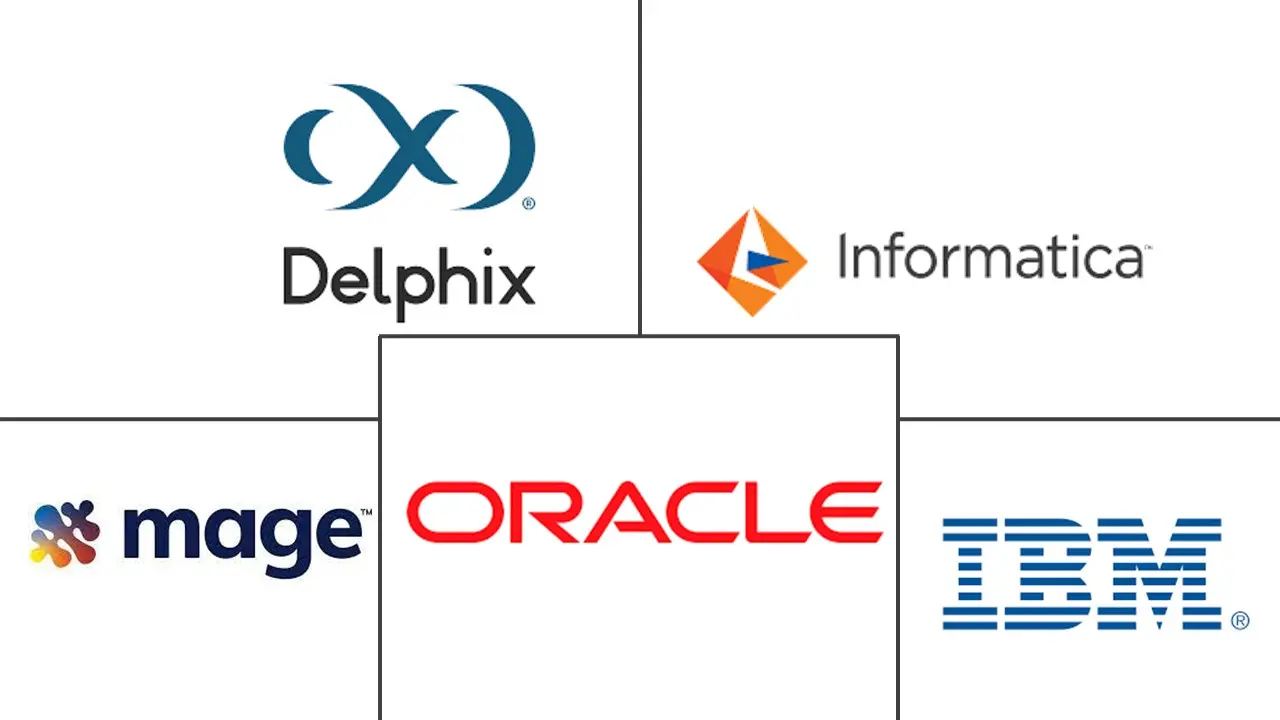Market Size of Data Masking Industry

| Study Period | 2019 - 2029 |
| Market Size (2024) | USD 0.94 Billion |
| Market Size (2029) | USD 1.87 Billion |
| CAGR (2024 - 2029) | 14.71 % |
| Fastest Growing Market | Asia-Pacific |
| Largest Market | North America |
| Market Concentration | Low |
Major Players
*Disclaimer: Major Players sorted in no particular order |
Data Masking Market Analysis
The Data Masking Market size is estimated at USD 0.94 billion in 2024, and is expected to reach USD 1.87 billion by 2029, growing at a CAGR of 14.71% during the forecast period (2024-2029).
In this information age, cyber security is essential. With the growth of breaches and malware attacks, data masking is making its way into the data-driven industry.
- Data masking is an intelligent technology that provides real-time data masking of production data. Data masking technology allows for analyzing large amounts of data without disrupting routine company processes. In other words, data masking technology produces a fake but realistic version of organizational data to safeguard sensitive organizational information.
- The increasing need for decreasing the risk of data breaching is fueling the dynamic data masking market growth, which is expected to execute the fastest growth rate over the forecast period. Besides, active data masking helps to protect sensitive and personal data while supporting outsourcing, offshoring, and cloud-based initiatives.
- Furthermore, considering the significant demand among enterprises for securing their financial data, the requirement for data masking and better security solutions is projected to play a vital role in the market's growth. Data-driven finance has mandated that every organization have an accounting department to store and maintain financial data that includes large monetary transactions that, if leaked, could result in issues with the company's reputation and monetary losses in the market, as well as issues with regulatory directives such as PCI DSS, HIPAA, and other enforced laws. This is the most crucial reason driving the growth of the data masking market in this business function.
- However, a lack of skilled workers and technological competence in poor and developing nations and a lack of standardization may limit market expansion. Increasing complexity in data integration and synchronization may also slow industry development. A solid IT infrastructure in developing nations would also hinder market expansion.
- Due to the COVID-19 outbreak, countries have implemented preventive measures. With schools being closed and communities being asked to stay at home, multiple organizations found a way to enable employees to work from their homes. This resulted in a rise in data breaches and fuels the growth of the data masking market. Due to rapid digitization, the market is also growing after the pandemic.
Data Masking Industry Segmentation
Data masking methodically changes private data elements such as trade secrets and personally-identifying information (PII) into realistic but fictitious values. Masking allows data recipients to use "production-like" information while complying with privacy protection regulations.
The scope of the study focuses on the market analysis of data masking solutions globally. Market sizing encompasses the revenue generated through proven data masking techniques globally sold by various market players. The study also tracks the key market parameters, underlying growth influencers, and major vendors operating in the industry, which supports the market estimations and growth rates over the forecast period. The study further analyzes the overall impact of COVID-19 on the ecosystem. The report's scope encompasses market sizing and forecast for segmentation by type, deployment, end-user industry, and geography. The market sizes and forecasts are provided in terms of value (USD million) for all the above segments.
| By Type | |
| Static | |
| Dynamic |
| By Deployment | |
| Cloud | |
| On-premise |
| By End-user Industry | |
| BFSI | |
| Healthcare | |
| IT and Telecom | |
| Retail | |
| Government and Defense | |
| Manufacturing | |
| Media and Entertainment | |
| Other End-user Industries |
| By Geography | |||||
| |||||
| |||||
| |||||
| Latin America | |||||
| Middle East and Africa |
Data Masking Market Size Summary
The data masking market is experiencing significant growth, driven by the increasing need for cybersecurity in an era marked by frequent data breaches and malware attacks. This technology enables organizations to analyze large datasets without compromising sensitive information, thereby supporting essential business processes while safeguarding data. The demand for data masking is particularly strong in sectors like BFSI, where protecting financial data is crucial due to the high stakes involved. The market is also benefiting from the rise of cloud computing and the need for secure data handling in outsourcing and offshoring initiatives. However, challenges such as a shortage of skilled professionals in developing regions and the complexity of data integration may hinder market expansion.
Regionally, the Asia Pacific is poised for rapid growth, fueled by the rapid digitization and technological advancements in countries like China and India. These nations are witnessing a surge in connected devices and big data generation, necessitating robust data security solutions. The competitive landscape of the data masking market is fragmented, with major players like IBM, Oracle, and Informatica engaging in strategic partnerships and product innovations to maintain their market positions. Regulatory developments, particularly in China, are also shaping the market dynamics, as stringent data privacy laws drive the adoption of data masking solutions.
Data Masking Market Size - Table of Contents
-
1. MARKET DYNAMICS
-
1.1 Market Overview
-
1.2 Introduction to Market Drivers and Restraints
-
1.3 Market Drivers
-
1.3.1 Increase of Organizational Data Volumes
-
-
1.4 Market Restraints
-
1.4.1 Technological Complexities Associated with Data Masking Challenge the Market Growth
-
-
1.5 Industry Attractiveness - Porter's Five Forces Analysis
-
1.5.1 Threat of New Entrants
-
1.5.2 Bargaining Power of Suppliers
-
1.5.3 Bargaining Power of Consumers
-
1.5.4 Threat of Substitutes
-
1.5.5 Intensity of Competitive Rivalry
-
-
1.6 Impact of COVID-19 on the Market
-
-
2. MARKET SEGMENTATION
-
2.1 By Type
-
2.1.1 Static
-
2.1.2 Dynamic
-
-
2.2 By Deployment
-
2.2.1 Cloud
-
2.2.2 On-premise
-
-
2.3 By End-user Industry
-
2.3.1 BFSI
-
2.3.2 Healthcare
-
2.3.3 IT and Telecom
-
2.3.4 Retail
-
2.3.5 Government and Defense
-
2.3.6 Manufacturing
-
2.3.7 Media and Entertainment
-
2.3.8 Other End-user Industries
-
-
2.4 By Geography
-
2.4.1 North America
-
2.4.1.1 United States
-
2.4.1.2 Canada
-
-
2.4.2 Europe
-
2.4.2.1 United Kingdom
-
2.4.2.2 Germany
-
2.4.2.3 Rest of Europe
-
-
2.4.3 Asia Pacific
-
2.4.3.1 China
-
2.4.3.2 India
-
2.4.3.3 Rest of Asia Pacific
-
-
2.4.4 Latin America
-
2.4.5 Middle East and Africa
-
-
Data Masking Market Size FAQs
How big is the Data Masking Market?
The Data Masking Market size is expected to reach USD 0.94 billion in 2024 and grow at a CAGR of 14.71% to reach USD 1.87 billion by 2029.
What is the current Data Masking Market size?
In 2024, the Data Masking Market size is expected to reach USD 0.94 billion.

